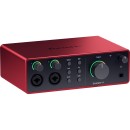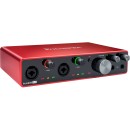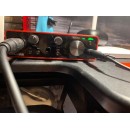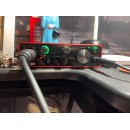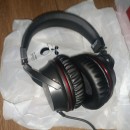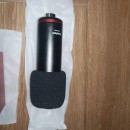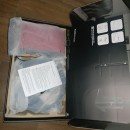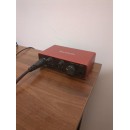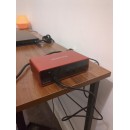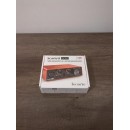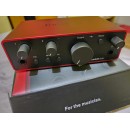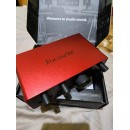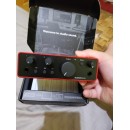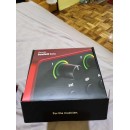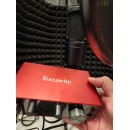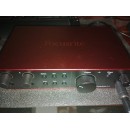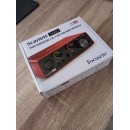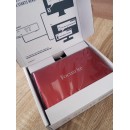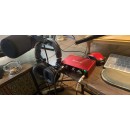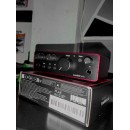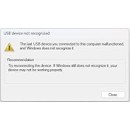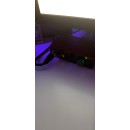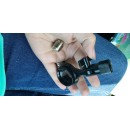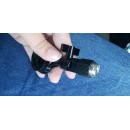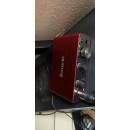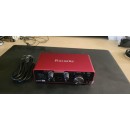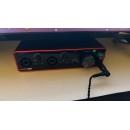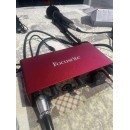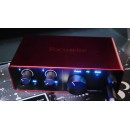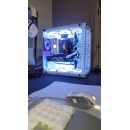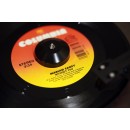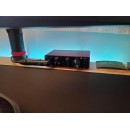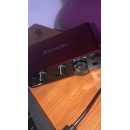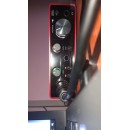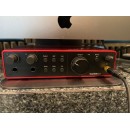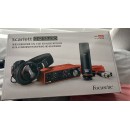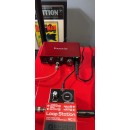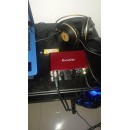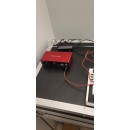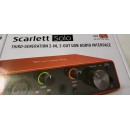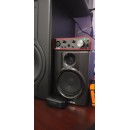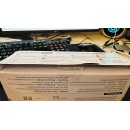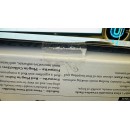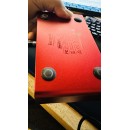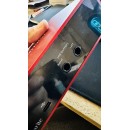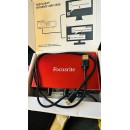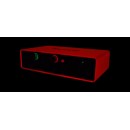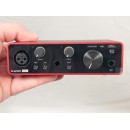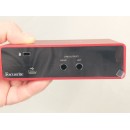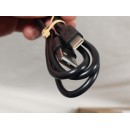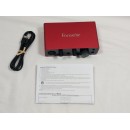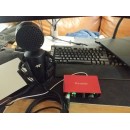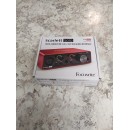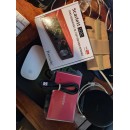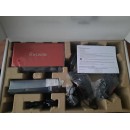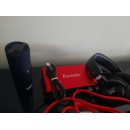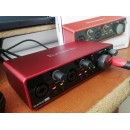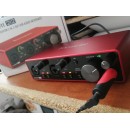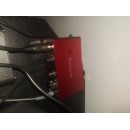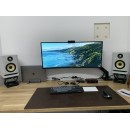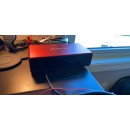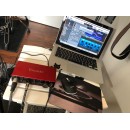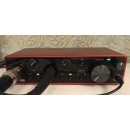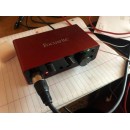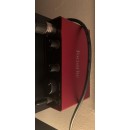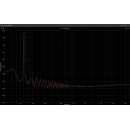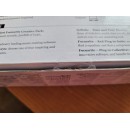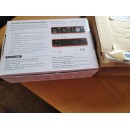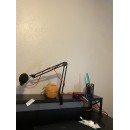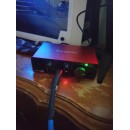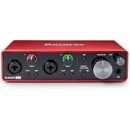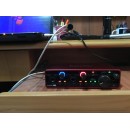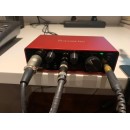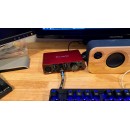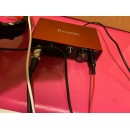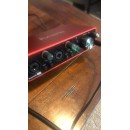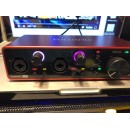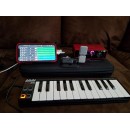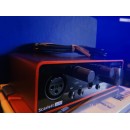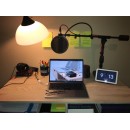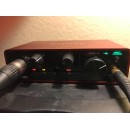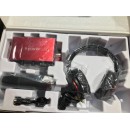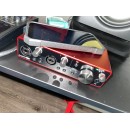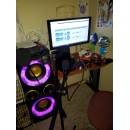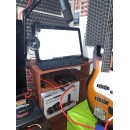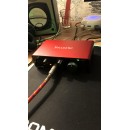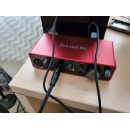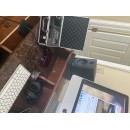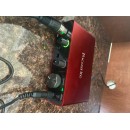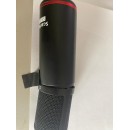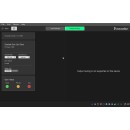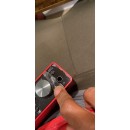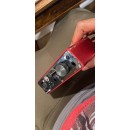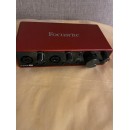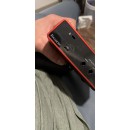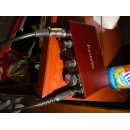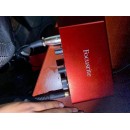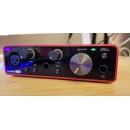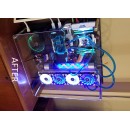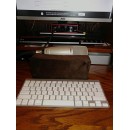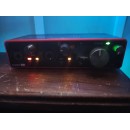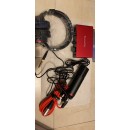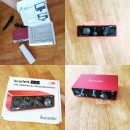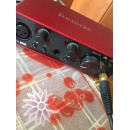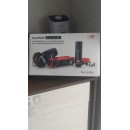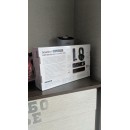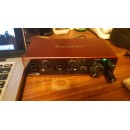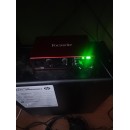Focusrite Scarlett 8i6 (3rd Gen) vs. Scarlett 4i4 (4th Gen): A Detailed Comparison
The Scarlett 4i4 (4th Gen) is a compact yet versatile interface, ideal for solo artists, small bands, and podcasters. It offers 4 inputs and 4 outputs, including two high-headroom instrument inputs, two balanced line inputs, and four balanced line outputs. The 4th Generation model benefits from upgraded preamps, providing even cleaner and more transparent sound quality. The USB-C connectivity ensures faster data transfer and improved power efficiency. Additionally, the 4i4 includes a pair of virtual loopback inputs, making it easier to capture stereo feeds from software applications.
On the other hand, the Scarlett 8i6 (3rd Gen) is designed for more demanding recording environments, offering a greater number of inputs and outputs—8 inputs and 6 outputs in total. This model includes two Scarlett mic preamps, six balanced line inputs, four balanced outputs, and two headphone outputs with separate volume controls. The 3rd Generation improvements include high-performance converters that operate at up to 24-bit/192kHz, ensuring professional-grade audio clarity. The 8i6 also features Focusrite’s Air mode, which emulates the famous ISA preamps to add brightness and presence to your recordings.
In summary, the Scarlett 4i4 (4th Gen) is an excellent choice for users who need a compact, high-quality interface with modern USB-C connectivity and upgraded preamps. The Scarlett 8i6 (3rd Gen) caters to more complex setups requiring additional inputs and outputs, making it suitable for multi-instrumentalists and small studios. Both models maintain Focusrite's reputation for reliability and superior audio performance.
Specifications, Advantages, and Disadvantages
| User Rating Based on Analysis of Reviews | |
|---|---|
|
Show More |
| Pros: | |
|---|---|
|
|
| Cons: | |
|---|---|
|
|
| Key Specs | |
|---|---|
| Channels of I/O | |
| Analog: 4 Inputs / 4 Outputs at 192 kHz |
Analog: 6 Input / 4 Output at 192 kHz Digital: 2 Input / 2 Output at 192 kHz |
| Maximum Sampling Rate | |
| 192 kHz / 24-Bit | 192 kHz / 24-Bit |
| Number of Microphone Inputs | |
| 2 | 2 Preamps |
| Analog Audio I/O | |
| 2x Combo XLR-1/4" 3-Pin Balanced/Unbalanced Mic/Line/Hi-Z Input (Front Panel) 2x 1/4" TRS Balanced/Unbalanced Line Input 4x 1/4" TRS Balanced/Unbalanced Line/Monitor Output 1x 1/4" TRS Headphone Output (Front Panel) |
2x Combo XLR-1/4" TRS Balanced/Unbalanced Mic/Line/Hi-Z Input (Front Panel) 4x 1/4" TRS Balanced Line Input 4x 1/4" TRS Balanced Line Output 2x 1/4" TRS Unbalanced Headphone Output (Front Panel) |
| Digital Audio I/O | |
|
1x RCA Coaxial S/PDIF Input 1x RCA Coaxial S/PDIF Output |
|
| Host Connection | |
| 1x USB-C | 1x USB-C |
| OS Compatibility | |
| macOS Windows |
macOS 10.12 or Later Windows 7 or Later |
| Power Requirements | |
| USB Bus Power, USB Power Adapter (Not Included) | AC/DC Power Adapter (Included) |
Starting with channels of I/O, the Scarlett 4i4 provides 4 analog inputs and 4 analog outputs, all operating at a maximum sampling rate of 192 kHz / 24-Bit. In contrast, the Scarlett 8i6 offers a more extensive range of I/O, with 6 analog inputs, 4 analog outputs, and an additional 2 digital inputs and 2 digital outputs, also at a 192 kHz / 24-Bit sampling rate. This means that the Scarlett 8i6 offers more input options and the flexibility of digital audio I/O, which the Scarlett 4i4 lacks.
When it comes to microphone inputs, both interfaces are equipped with 2 microphone preamps. However, the analog audio I/O configuration differs between the models. The Scarlett 4i4 features 2 combo XLR-1/4" 3-Pin balanced/unbalanced mic/line/Hi-Z inputs on the front panel, 2 additional 1/4" TRS balanced/unbalanced line inputs, 4 TRS balanced/unbalanced line/monitor outputs, and a single 1/4" TRS headphone output located on the front panel. On the other hand, the Scarlett 8i6 includes 2 combo XLR-1/4" TRS balanced/unbalanced mic/line/Hi-Z inputs on the front panel, 4 TRS balanced line inputs, 4 TRS balanced line outputs, and two 1/4" TRS unbalanced headphone outputs on the front panel, thus providing an additional headphone output compared to the 4i4.
Regarding digital audio I/O, the Scarlett 4i4 does not include any digital audio inputs or outputs. In contrast, the Scarlett 8i6 is equipped with 1 RCA coaxial S/PDIF input and 1 RCA coaxial S/PDIF output, offering more flexibility for users who need digital connectivity.
Both models share similar host connection capabilities, each featuring a single USB-C port for connection to a host computer. They are also compatible with macOS and Windows operating systems. However, their power requirements differ: the Scarlett 4i4 can be powered via USB bus power or an optional USB power adapter (not included), while the Scarlett 8i6 requires an AC/DC power adapter, which is included with the device.
In summary, the Scarlett 4i4 is more compact with fewer I/O options, making it suitable for users with simpler setups, while the Scarlett 8i6 offers a broader range of inputs and outputs, including digital I/O, making it a more versatile choice for users needing more extensive connectivity and flexibility.
| General | |
|---|---|
| Channels of I/O | |
| Analog: 4 Inputs / 4 Outputs at 192 kHz |
Analog: 6 Input / 4 Output at 192 kHz Digital: 2 Input / 2 Output at 192 kHz |
| Maximum Sampling Rate | |
| 192 kHz / 24-Bit | 192 kHz / 24-Bit |
| Number of Microphone Inputs | |
| 2 | 2 Preamps |
| Input Level Adjustment | |
| 2x Knob | 2x Knob |
| Expansion Slots | |
The Scarlett 4i4 (4th Generation) provides 4 analog inputs and 4 analog outputs at a maximum sampling rate of 192 kHz / 24-bit. It features 2 microphone inputs but does not include built-in DSP or built-in microphones. Input level adjustment is managed via 2 knobs, and there are no expansion slots available.
In contrast, the Scarlett 8i6 (3rd Generation) offers a more extensive I/O configuration with 6 analog inputs and 4 analog outputs, as well as 2 digital inputs and 2 digital outputs, all at the same maximum sampling rate of 192 kHz / 24-bit. Similar to the 4i4, it includes 2 microphone preamps and uses 2 knobs for input level adjustment. This model also lacks expansion slots, aligning with the 4i4 in that regard.
Overall, while both interfaces provide high-quality audio resolution and similar control features, the Scarlett 8i6 stands out with its additional analog and digital I/O capabilities, making it a more versatile option for users requiring more extensive connectivity options.
| Signal Processing | |
|---|---|
| Gain/Trim Range | |
| Mic/Line Inputs: Up to +69 dB Hi-Z Inputs: 62 dB |
Mic/Line Inputs: Up to +56 dB |
In contrast, the Focusrite Scarlett 8i6 8x6 USB Audio/MIDI Interface (3rd Generation) offers a gain/trim range for mic/line inputs of up to +56 dB. Additionally, it features a switchable pad of -10 dB for mic/line/Hi-Z inputs, which can help manage high-level input signals and prevent clipping. Unlike the 4i4, the 8i6 does not include a high-pass filter or solo/mute functions.
In summary, the Scarlett 4i4 (4th Gen) provides a higher gain range compared to the Scarlett 8i6 (3rd Gen), making it potentially more versatile for different recording scenarios. However, the Scarlett 8i6 (3rd Gen) offers a switchable pad feature, which can be useful for handling louder input sources.
| Connectivity | |
|---|---|
| Analog Audio I/O | |
| 2x Combo XLR-1/4" 3-Pin Balanced/Unbalanced Mic/Line/Hi-Z Input (Front Panel) 2x 1/4" TRS Balanced/Unbalanced Line Input 4x 1/4" TRS Balanced/Unbalanced Line/Monitor Output 1x 1/4" TRS Headphone Output (Front Panel) |
2x Combo XLR-1/4" TRS Balanced/Unbalanced Mic/Line/Hi-Z Input (Front Panel) 4x 1/4" TRS Balanced Line Input 4x 1/4" TRS Balanced Line Output 2x 1/4" TRS Unbalanced Headphone Output (Front Panel) |
| Phantom Power | |
| 48 V, Selectable On/Off | 48 V, Selectable On/Off (on 2 Channels) |
| Digital Audio I/O | |
|
1x RCA Coaxial S/PDIF Input 1x RCA Coaxial S/PDIF Output |
|
| Host Connection | |
| 1x USB-C | 1x USB-C |
| Host Connection Protocol | |
| USB 2.0 | USB 2.0 |
| MIDI I/O | |
| 1x DIN 5-Pin Input 1x DIN 5-Pin Output |
1x DIN 5-Pin Input 1x DIN 5-Pin Output |
The Scarlett 4i4 (4th Generation) provides a compact yet versatile setup with 2 combo XLR-1/4" inputs on the front panel, which can handle mic, line, and Hi-Z signals, and 2 additional 1/4" TRS balanced/unbalanced line inputs. It supports 4 balanced/unbalanced line/monitor outputs and a single 1/4" TRS headphone output on the front panel. Phantom power is selectable and can be turned on or off as needed. Connectivity is streamlined with a single USB-C host connection using USB 2.0 protocol, and it includes a dedicated USB-C port for power input. MIDI connectivity is supported with 1x DIN 5-pin input and 1x DIN 5-pin output. Notably, the Scarlett 4i4 lacks digital audio I/O and sync/network capabilities, making it ideal for simpler setups that do not require these advanced features.
In contrast, the Scarlett 8i6 (3rd Generation) expands upon the 4i4's capabilities with a more extensive input/output configuration. It features the same 2 combo XLR-1/4" TRS inputs on the front panel but adds 4 additional 1/4" TRS balanced line inputs for greater flexibility in connecting multiple instruments and audio sources. The output options include 4 balanced line outputs and 2 unbalanced headphone outputs, both accessible from the front panel. Like the 4i4, it offers 48V phantom power, which can be toggled on or off for two channels. The Scarlett 8i6 also includes digital audio I/O with 1x RCA coaxial S/PDIF input and 1x RCA coaxial S/PDIF output, providing additional options for digital connectivity. It connects to the host via a USB-C port using USB 2.0 protocol and supports MIDI I/O with 1x DIN 5-pin input and 1x DIN 5-pin output.
Overall, the Scarlett 4i4 is well-suited for users who need a straightforward interface with essential analog and MIDI connectivity, while the Scarlett 8i6 caters to those requiring more extensive analog and digital I/O options for complex recording setups.
| Performance | |
|---|---|
| Frequency Response | |
| Combo XLR-1/4" Mic Inputs: 20 Hz to 20 kHz ±0.06 dB Combo XLR-1/4" Line Inputs: 20 Hz to 20 kHz ±0.05 dB Combo XLR-1/4" Hi-Z Inputs: 20 Hz to 20 kHz ±0.15 dB 1/4" Line Inputs: 20 Hz to 20 kHz ±0.02 dB |
20 Hz to 20 kHz ±0.1 dB |
| Maximum Input Level | |
| Combo XLR-1/4" Mic: 16 dBu Combo XLR-1/4" Line: 22 dBu Combo XLR-1/4" Hi-Z: 12 dBu 1/4" Line: 22 dBu |
Mic Inputs: +9 dBu (Min Gain) +16 dBu (Min Gain, with Pad) Hi-Z Inputs: +12.5 dBu (Min Gain) +14 dBu (Min Gain, with Pad) Line Inputs: +22 dBu (Min Gain) +29 dBu (Min Gain, with Pad) |
| Maximum Output Level | |
| 1/4" Line: +16 dBu |
Line Outputs: +15.5 dBu (Balanced) Headphone Outputs: +7 dBu |
| Impedance | |
| Combo XLR-1/4" Mic Inputs: 3 Kilohms Combo XLR-1/4" Line Inputs: 60 Kilohms Combo XLR-1/4" Hi-Z Inputs: 1 Megohms 1/4" Line Inputs: 60 Kilohms 1/4" Line Outputs: 100 Ohms 1/4" Headphone Outputs: < 11 Ohm |
Mic Inputs: 3 Kilohms Hi-Z Inputs: 1.5 Megohms Line Inputs: 60 Kilohms Line Outputs: 430 Ohms Headphone Outputs: < 1 Ohm |
| Dynamic Range | |
| Combo XLR-1/4" Mic Inputs: 116 dBA Combo XLR-1/4" Line Inputs: 115.5 dBA Combo XLR-1/4" Hi-Z Inputs: 113 dBA 1/4" Line Inputs: 115.5 dBA 1/4" Line Outputs: 120 dB 1/4" Headphone: 112 dB (at 33 Ohms) 115 dB (at 300 Ohms) Digital A/D Converters: 130 dB Digital D/A Converters: 130 dBA |
Mic Inputs: 111 dBA Hi-Z Inputs: 110.5 dBA Line Inputs: 110.5 dBA Line Outputs: 108.5 dBA Headphone Outputs: 104 dBA |
| THD+N | |
| Combo XLR-1/4" Mic Inputs: -100 dB (at 8 dB Gain) Combo XLR-1/4" Line Inputs: -100 dB (at 8 dB Gain) Combo XLR-1/4" Hi-Z Inputs: -80 dB (at Minimum Gain) 1/4" Line Inputs: -105 dB 1/4" Line Outputs: -112 dB 1/4" Headphone Outputs: -99 dB (at 33 Ohms) -108 dB (at 300 Ohms) Digital A/D Converters: -115 dB Digital D/A Converters: -115 dB |
Mic Inputs: < 0.0012% Hi-Z Inputs: < 0.03% Line Inputs: < 0.002% Line Outputs: < 0.002% Headphone Outputs: < 0.002% |
| EIN | |
| Combo XLR-1/4" Mic Inputs: -127 dBu A-Weighted |
Mic Inputs: -128 dB A-Weighted |
In terms of frequency response, the Scarlett 4i4 offers a more precise range across its various input types. For example, the Combo XLR-1/4" Line Inputs have a frequency response of 20 Hz to 20 kHz ±0.05 dB, while the Scarlett 8i6 provides a slightly less precise 20 Hz to 20 kHz ±0.1 dB. This indicates the Scarlett 4i4 might provide a slightly more accurate sound reproduction across the frequency spectrum.
The maximum input levels also differ between the two models. The Scarlett 4i4’s Combo XLR-1/4" Line Inputs can handle up to 22 dBu, while the Scarlett 8i6’s Line Inputs can handle up to 29 dBu with the pad engaged. This suggests that the Scarlett 8i6 can accommodate higher line-level signals, making it more versatile for handling louder sources without distortion.
Regarding output capabilities, the Scarlett 4i4 has a maximum output level of +16 dBu for 1/4" Line Outputs, whereas the Scarlett 8i6 provides a slightly lower +15.5 dBu for balanced Line Outputs. The headphone output power of the Scarlett 4i4 is notably higher, with 57 mW into 33 Ohms and 27 mW into 300 Ohms, compared to the Scarlett 8i6’s +7 dBu.
The impedance levels vary as well, with the Scarlett 4i4 featuring a lower headphone output impedance (<11 Ohms) compared to the Scarlett 8i6 (<1 Ohm). This can impact the performance and compatibility with different headphone models.
When it comes to dynamic range, the Scarlett 4i4 generally provides higher figures. For instance, its 1/4" Line Outputs feature a dynamic range of 120 dB, while the Scarlett 8i6 offers 108.5 dBA. Similarly, the Scarlett 4i4’s Combo XLR-1/4" Mic Inputs boast a dynamic range of 116 dBA, compared to the Scarlett 8i6’s 111 dBA for Mic Inputs.
In terms of Total Harmonic Distortion plus Noise (THD+N), the Scarlett 4i4 offers better performance figures across most inputs and outputs. For example, the 1/4" Line Inputs on the Scarlett 4i4 have a THD+N of -105 dB, while the Scarlett 8i6’s Line Inputs have a THD+N of <0.002%. This suggests that the Scarlett 4i4 might provide cleaner audio with less distortion.
Lastly, the Equivalent Input Noise (EIN) shows a slight edge for the Scarlett 8i6 with -128 dB A-weighted compared to the Scarlett 4i4’s -127 dBu A-weighted, indicating that the Scarlett 8i6 might have marginally lower self-noise.
In summary, while both interfaces offer professional-grade audio performance, the Scarlett 4i4 (4th Generation) generally provides higher dynamic range and lower THD+N values, indicating potentially cleaner and more precise audio capabilities. The Scarlett 8i6 (3rd Generation), on the other hand, offers higher maximum input levels and can accommodate louder sources, making it slightly more versatile in certain scenarios.
| Digital Audio | |
|---|---|
| Sample Rates | |
| 44.1 / 48 / 88.2 / 96 / 176.4 / 192 kHz | Up to 192 kHz (AD/DA Conversion) |
| Bit Depths | |
| 24-Bit | Up to 24-Bit (AD/DA Conversion) |
| Sync Sources | |
| Internal | Internal, S/PDIF |
Starting with sample rates, the Scarlett 4i4 offers a consistent range of 44.1 / 48 / 88.2 / 96 / 176.4 / 192 kHz, providing versatility for various recording needs. On the other hand, the Scarlett 8i6 supports sample rates up to 192 kHz for AD/DA conversion, allowing for high-resolution audio quality but does not specify individual rates like the 4i4 does.
Regarding bit depths, both interfaces support 24-bit resolution, which ensures high-quality audio recording and playback. However, the Scarlett 8i6 specifies that this bit depth is applicable to AD/DA conversion processes.
In terms of sync sources, the Scarlett 4i4 relies solely on an internal sync source, which is standard for many compact interfaces. In contrast, the Scarlett 8i6 offers more flexibility with both internal and S/PDIF sync sources, catering to more complex studio setups that may require digital synchronization with other equipment.
These comparisons reflect the primary distinctions and similarities between these two interfaces based on the provided specifications, highlighting the 4i4's straightforward approach and the 8i6's additional synchronization capabilities.
| Audio Storage & Playback |
|---|
| Compatibility | |
|---|---|
| OS Compatibility | |
| macOS Windows |
macOS 10.12 or Later Windows 7 or Later |
The Focusrite Scarlett 4i4 (4th Generation) is compatible with both macOS and Windows operating systems, ensuring broad usability. Additionally, it supports mobile app compatibility specifically for iPadOS, which makes it handy for users who prefer integrating with iPads for mobile recording and mixing tasks. This feature extends its versatility, allowing users to have a more portable setup without compromising on functionality.
On the other hand, the Focusrite Scarlett 8i6 (3rd Generation) is compatible with macOS 10.12 or later and Windows 7 or later, also covering a wide range of operating systems. However, this interface has specific hardware and software requirements. It necessitates an available USB 2.0 port and includes a USB cable for connectivity. Moreover, an internet connection is required for downloading the necessary software and drivers, which adds an additional step for initial setup.
In summary, while both interfaces are compatible with macOS and Windows, the Scarlett 4i4 (4th Generation) offers mobile app compatibility for iPadOS, enhancing its portability. The Scarlett 8i6 (3rd Generation), however, requires specific hardware and an internet connection for software installation, which might be a consideration for users with limited internet access or older hardware setups.
| Power | |
|---|---|
| Power Requirements | |
| USB Bus Power, USB Power Adapter (Not Included) | AC/DC Power Adapter (Included) |
| AC/DC Power Adapter | |
| 5 VDC at 3 A (Included) | 12 VDC at 1 A, Center-Positive (Included) |
The Scarlett 4i4 (4th Generation) is versatile in its power options, offering USB Bus Power and the ability to use a USB Power Adapter (not included). Additionally, it includes an AC/DC power adapter that operates at 5 VDC and 3 A, with a total power consumption of 7.5 W. This flexibility allows users to choose between powering the interface directly from their computer via USB or using an external power source, making it a convenient option for both studio and mobile recording setups.
On the other hand, the Scarlett 8i6 (3rd Generation) relies solely on an included AC/DC power adapter for its power requirements. The adapter provides 12 VDC at 1 A with a center-positive configuration. This setup indicates that the 8i6 needs a dedicated external power source, which can be seen as a more traditional and perhaps stable power supply method compared to the 4i4's USB bus power option.
In summary, the Scarlett 4i4 (4th Generation) offers more flexibility with its power options, including USB Bus Power and an AC/DC adapter with higher power consumption, while the Scarlett 8i6 (3rd Generation) relies on a single, included AC/DC power adapter for its operation.
| Physical | |
|---|---|
| Dimensions | |
| 7.09 x 5.08 x 2.32" / 18.01 x 12.9 x 5.89 cm | 8.27 x 5.89 x 1.87" / 21.01 x 14.96 x 4.75 cm |
| Weight | |
| 1.8 lb / 816.0 g |
1.9 lb / 0.9 kg (without Accessories) 2.4 lb / 1.1 kg (with Accessories) |
In contrast, the Focusrite Scarlett 8i6 8x6 USB Audio/MIDI Interface (3rd Generation) has dimensions of 8.27 x 5.89 x 1.87 inches (21.01 x 14.96 x 4.75 cm) and weighs 1.9 lb (0.9 kg) without accessories and 2.4 lb (1.1 kg) with accessories. Additionally, it features a Kensington Security Slot for anti-theft protection, adding an extra layer of security for studio environments.
When comparing dimensions and weight, the Scarlett 4i4 is slightly smaller and lighter than the Scarlett 8i6, making it more convenient for portability. However, the Scarlett 8i6 offers additional security features with the Kensington Security Slot, which may be beneficial in fixed studio settings.
| Packaging Info | |
|---|---|
| Package Weight | |
| 3.185 lb | 3.45 lb |
| Box Dimensions (LxWxH) | |
| 11.2 x 8 x 3.6" | 13.1 x 11.7 x 3.5" |
The Focusrite Scarlett 4i4 (4th Generation) has a package weight of 3.185 lb, making it slightly lighter than its counterpart. Its box dimensions measure 11.2 x 8 x 3.6 inches, suggesting a more compact size which may appeal to users looking for a more portable solution.
On the other hand, the Focusrite Scarlett 8i6 (3rd Generation) comes with a package weight of 3.45 lb, indicating it is marginally heavier. The box dimensions for the 8i6 are 13.1 x 11.7 x 3.5 inches, which means it occupies more space, potentially offering a more robust build or additional features that could justify the larger size.
In summary, the Scarlett 4i4 (4th Generation) is lighter and more compact compared to the Scarlett 8i6 (3rd Generation), which is slightly heavier and larger in its packaging. These differences might influence a user's decision based on their specific needs for portability and space.
| Customer Images | |
|---|---|
| Videos | |
|---|---|
|
|
|
